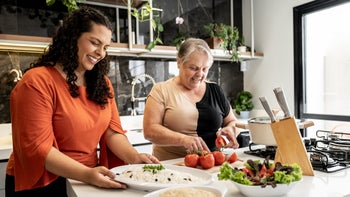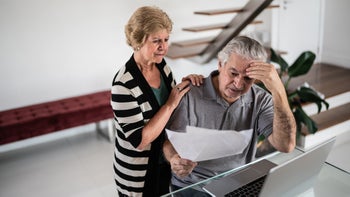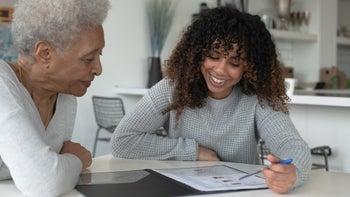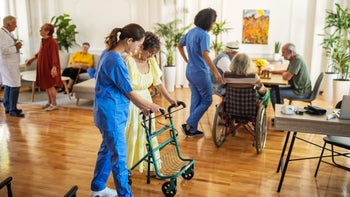
The 8 Best Balance Exercises for Seniors
Key takeaways:
Maintaining balance requires multiple parts of the body to work together.
Balance declines with age, raising the risk of falls and other injuries among older adults.
Balance exercises for seniors can help older adults prevent falls, improve functional mobility, and stay independent.
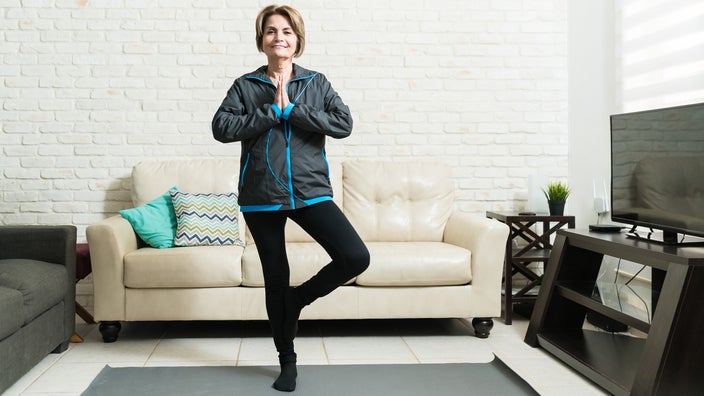
You might take your sense of balance for granted. But staying steady on your feet is critical for functional mobility. It affects how you move in your daily life, from standing and walking to sitting and bending down to tie your shoes. But balance and coordination worsen as we age. In fact, researchers estimate that balance begins to decline at age 50.
That's why experts recommend balance exercises for older adults. And you don't have to wait to get started. You can benefit from balance training at any age.
8 best balance exercises for seniors
The best balance exercises for seniors should activate and strengthen core and lower-body muscles. These moves should be part of your weekly fitness routine, like regular aerobic, strength-training, and flexibility exercises. Make sure you check with your healthcare provider before trying any new moves.
Search and compare options
1. Single-leg stance
Standing on one leg is a great way to test your stability and measure your progress after you start balance training. The ability to do so has been linked to better cognitive health and longevity.
Step 1
Stand behind a counter or sturdy chair with your back straight and your feet together.
Step 2
Slowly lift your right foot off the floor. If you need extra support, hold the back of the chair or counter with both hands as you lift your foot.
Step 3
Bend your right knee to a 90-degree angle.
Step 4
Hold the stance and maintain your balance for 10 seconds.
Step 5
Lower your right foot back to the floor.
Read more like this
Explore these related articles, suggested for readers like you.
Step 6
Repeat the exercise 10 to 15 times on each foot. Try to up your single-leg balance time, aiming for 30 to 60 seconds.
2. Tree pose
Yoga is one of many ways to improve your balance and flexibility. You can advance to tree pose after practicing the single-leg stance.
Step 1
Stand with your shoulders down, back straight, and feet together. Rest your hands on your hips.
Step 2
Shift your weight to your right foot and bend your left knee, placing your left foot flat against the side of your right calf.
Step 3
Place your left foot against your right inner thigh for an advanced version. But make sure not to put your foot against your knee. Putting pressure on the knee can move it out of alignment and may cause discomfort or pain.
Step 4
Clasp your hands in front of your chest. Or lift your arms above your head (like the branches of a tree) if you can.
Step 5
Hold the pose for 10 to 15 seconds, and then switch legs.
3. Heel-toe raises
Shuffling your feet when you walk instead of lifting each foot off the ground can cause falls. Heel-toe raises can strengthen your shin and ankle muscles, helping you walk more efficiently. You can do them seated or standing, depending on your ability level.
Step 1
Sit or stand upright with your back straight and your hands in your lap or on your hips. Keep your feet flat on the floor.
Step 2
Press into the balls of your feet to lift your heels and stand on your tiptoes. Hold for 5 to seconds before lowering your feet flat on the floor.
Step 3
Press into your heels and lift your toes as high as you can, hinging at your ankles. Try to do each raise slowly and with control. Hold for 5 to seconds before placing your feet flat on the floor.
4. Heel-to-toe walking
Heel-to-toe walking helps you practice your balance and coordination skills. If you are unsteady on your feet, try this move near a wall so you can hold onto it for extra support.
Step 1
Stand tall with your feet shoulder-width apart.
Step 2
Keep your shoulders down as you hold your arms out at your sides, palms facing the floor.
Step 3
Take one step forward with your right foot, allowing your right heel to touch your left toes.
Step 4
Keep walking in a straight line, placing each foot directly in front of the other with every step.
Step 5
Continue this heel-to-toe walking pattern for 20 to 30 paces.
5. Sit-to-stand
This exercise mimics one of many functional movements that are important for activities of daily living. It can boost core and leg strength and help you build dynamic or moving balance.
Step 1
Scoot toward the front of your chair with your back straight and your feet hip-width apart. You can rest your hands on your lap or the armrests.
Step 2
Engage your core and press your feet into the floor as you stand up from your seat.
Step 3
Pause for a breath while standing tall.
Step 4
Hinge at your hips and bend your knees to sit down, returning to the starting position.
Step 5
Repeat this move 10 to 15 times.
6. Dead bug
Despite its funny name, the dead bug offers serious health benefits. The exercise stabilizes core muscles in your stomach, low back, and hips. And it challenges your balance and coordination skills.
Step 1
Lie on your back with your knees bent, feet flat on the floor, and arms extended toward the ceiling.
Step 2
Draw your belly button toward your spine to engage your core.
Step 3
Lower your left arm back towards the floor as you extend your right leg. Keep your lower back on the floor as you hold your left arm and right leg just above the floor.
Step 4
Hold briefly before lifting your left arm and right leg back to the starting position.
Step 5
Repeat steps 2 to 4 with your right arm and left leg.
Step 6
Complete 5 to 10 reps on each side.
7. Side leg raises
Standing side leg raises can improve stability by working your hips, glutes, and abs.
Step 1
Stand upright behind a sturdy chair with feet shoulder-width apart. Put your hands on your hips or hold the back of the chair for support.
Step 2
Engage your core and shift your weight to your left foot.
Step 3
Slowly lift your right leg out to the side, keeping your foot flexed.
Step 4
Hold for 10 to 15 seconds before returning to the starting position.
Step 5
Complete 10 to 15 reps on each side.
8. Walking lunges
Lunges are a go-to move for many and with good reason. They can boost lower-body strength and improve your balance and functional fitness. Be sure to master the lunge before you try this advanced version.
Step 1
Stand up straight with your feet hip-width apart and hands on your hips.
Step 2
Engage your core and look straight ahead.
Step 3
Take a big step forward –– about 2 to 3 feet –– with your right foot.
Step 4
Bend your knees to lower into a forward lunge. Your right knee should be at a 90-degree angle, and your left knee should be just above the floor.
Step 5
Press your feet into the floor to stand up from the lunge.
Step 6
Repeat steps 2 to 5 with your left leg.
Step 7
Keep switching between your right and left legs as you step forward with each lunge.
What causes poor balance in seniors?
Maintaining your balance requires several parts of your body to work together, including the:
Central nervous system
Eyes
Inner ear
Muscles, bones, and joints
Age-related changes can impair one or more of these systems, causing balance problems. For example, musculoskeletal changes like less muscle mass and bone density may affect your posture and the way you walk (gait). Slower or limited mobility can make you unstable on your feet, resulting in falls. This is critical because 1 in 4 adults ages 65 or older falls every year.
Various health conditions — such as arthritis, inner ear disorders, and vision problems — can also cause balance problems. Certain medications, like sleep aids and high blood pressure medications, may also be the culprit.
What are the benefits of balance exercises for seniors?
Your balance is essential to your health and well-being as you age. Balance exercises — including practices such as yoga and tai chi — can help older adults:
Lower the risk of falls and other injuries
Improve functional mobility
Boost cognitive function
The bottom line
Proper balance is an important but sometimes overlooked part of your health, especially as you age. Balance exercises for older adults should stretch and strengthen core and lower-body muscles. Adding them to your fitness plan has been shown to lower the risk of falls, improve mobility, and enhance well-being.
Why trust our experts?



References
American Council on Exercise. (n.d.). Supine dead bug.
American Heart Association. (2018). Balance exercise.
Antoian, F. (2016). 5 lunge variations you need to try. American Council on Exercise.
Centers for Disease Control and Prevention. (2021). Facts about falls.
Cooper, R., et al. (2014). Physical capability in mid-life and survival over 13 years of follow-up: British birth cohort study. BMJ.
Dorner, T., et al. (2007). The effect of structured strength and balance training on cognitive function in frail, cognitive impaired elderly long-term care residents. Aging Clinical and Experimental Research.
Dunsky, A. (2019). The effect of balance and coordination exercises on quality of life in older adults: A mini-review. Frontiers in Aging Neuroscience.
Edemekong, P. F., et al. (2022). Activities of daily living. StatPearls.
Hall, K. S., et al. (2017). Physical performance across the adult life span: Correlates with age and physical activity. The Journals of Gerontology: Series A.
Halvarsson, A., et al. (2015). Taking balance training for older adults one step further: the rationale for and a description of a proven balance training programme. Clinical Rehabilitation.
HealthinAging.org. (2023). Balance problems.
Jeter, P. E., et al. (2014). A systematic review of yoga for balance in a healthy population. Journal of Alternative and Complementary Medicine.
Matthews, J. (2015). Yoga for active older adults: 6 accessible poses to enhance functional capacity. American Council on Exercise.
MedlinePlus. (n.d.). Aging changes in the bones –muscles– joints.
National Institute on Aging. (2013). Heel-to-toe walk balance exercise for older adults. [Video].
National Institute on Aging. (2013). Stand on one foot balance exercise for older adults. [Video].
National Institute on Aging. (2021). Four types of exercise can improve your health and physical ability.
National Institute on Aging. (2022). Older adults and balance problems.
Sherrington, C., et al. (2020). Evidence on physical activity and falls prevention for people aged 65+ years: Systematic review to inform the WHO guidelines on physical activity and sedentary behaviour. International Journal of Behavioral Nutrition and Physical Activity.
Tabara, Y., et al. (2014). Association of postural instability with asymptomatic cerebrovascular damage and cognitive decline. The Japan Shimanami Health Promoting Program Study.
Watson, M. A., et al. (n.d.). The human balance system. Vestibular Disorders Association.
Youkhana, S., et al. (2015). Yoga-based exercise improves balance and mobility in people aged 60 and over: a systematic review and meta-analysis. Age and Ageing.








